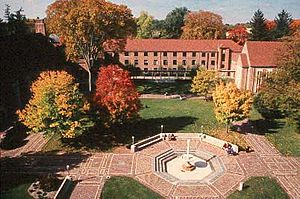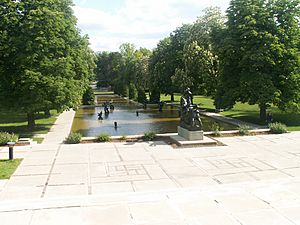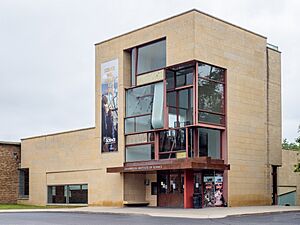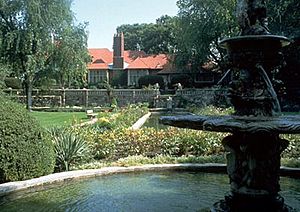Cranbrook Educational Community facts for kids
|
Cranbrook
|
|
| Location | 39221 Woodward Avenue Bloomfield Hills, Michigan |
|---|---|
| Built | 1926–99 |
| Architect | Eliel Saarinen |
| Architectural style | 20th Century American |
| NRHP reference No. | 73000954 |
Quick facts for kids Significant dates |
|
| Added to NRHP | March 7, 1973 |
| Designated NHLD | June 29, 1989 |
The Cranbrook Educational Community is a special place in Bloomfield Hills, Michigan. It's a group of schools, museums, and research centers. This amazing campus was started in the early 1900s. It was founded by George Gough Booth, who owned newspapers, and his wife, Ellen Scripps Booth.
Cranbrook is home to several important places:
- Cranbrook Schools
- Cranbrook Academy of Art
- Cranbrook Art Museum
- Cranbrook Institute of Science
- Cranbrook House and Gardens
The founders also built Christ Church Cranbrook nearby. It was meant to be a central part of the community. However, the church is now a separate organization. The whole campus is very large, covering about 319 acres. It started as a 174-acre farm bought in 1904. Cranbrook got its name from Cranbrook, England. This was the birthplace of George Booth's father.
Cranbrook is famous for its beautiful buildings. They are designed in the Arts and Crafts and Art Deco styles. The main architect was Eliel Saarinen. Albert Kahn designed Cranbrook House. Famous sculptors like Carl Milles and Marshall Fredericks also worked there for many years. In 2024, Cranbrook Educational Community received 3 Michelin Stars. This award is given by the Michelin Green Guide. It puts Cranbrook in the same league as major art museums.
Contents
Discover the Schools at Cranbrook
Cranbrook Schools include three different parts. There is an "upper" school for older students. It is for both day students and those who live there. There is also a middle school and the Brookside Lower School.
Brookside School: A Community Start
The first school to open at Cranbrook was the Bloomfield Hills School. This happened in 1922. George and Ellen Booth started it as a school for local children. Over time, this school became known as Brookside School.
Cranbrook School for Boys
After Brookside, the Booths wanted to build a school for boys. This would be a college-prep school. Boys from Detroit and other places would come to live and study there. George Booth wanted the school to look like the best British boarding schools. He hired Finnish architect Eliel Saarinen to design the campus. The first buildings for the boys' school were finished in 1928.
Over the years, the Cranbrook School for Boys grew. New buildings were added, like Stevens Hall and Page Hall. These were mainly dorms for students. The campus also got gyms and a science center.
Kingswood School for Girls
Ellen Scripps Booth believed girls also needed their own school. She pushed her husband to build one. She oversaw the project herself. She named it the Kingswood School Cranbrook. Unlike the boys' school, Kingswood was all in one building. It had dorms, a dining hall, classrooms, and even a bowling alley. Ellen encouraged Eliel Saarinen to create a unique design for the inside. At first, Kingswood was seen as a "finishing school." This meant it focused on social skills. But its education changed and grew over time.
In 1986, the Cranbrook School for Boys and Kingswood School Cranbrook joined together. They became the Cranbrook Kingswood Upper School.
Cranbrook Academy of Art: A Hub for Creativity
The Cranbrook Academy of Art is a special school. It is for students who want to study architecture, art, and design after college. George and Ellen Booth founded it in 1932. In 1984, The New York Times newspaper said that Cranbrook had a huge impact on American design. It called Cranbrook "synonymous with contemporary American design."
The school buildings were designed by Eliel Saarinen. He was also the first head of the school. He brought together ideas from the Arts and Crafts movement and the international style. The Academy is known for its unique teaching method. It's like an apprenticeship. A small group of students, usually 10 to 16, study with one artist-in-residence. There are no regular classes. Students learn on their own, guided by their artist-teacher.
What You Can Study
The Academy offers two main degrees. These are the Master of Fine Arts and the Master of Architecture. The Master of Architecture degree is for students who already have an architecture degree.
Cranbrook Art Academy has 11 departments today:
- 2D Design
- 3D Design
- 4D Design
- Architecture
- Ceramics
- Fiber
- Metalsmithing
- Painting
- Photography
- Print Media
- Sculpture
The newest department, 4D Design, started in 2019. Paul Sacaridiz became the Director of the Academy in 2022.
Cranbrook Art Museum: See Amazing Art
The Cranbrook Art Museum shows contemporary art. This means art from recent times. It has a permanent collection with works by famous artists. These include Charles and Ray Eames, Harry Bertoia, and Andy Warhol. The museum building was finished in 1942. It was designed by architect Eliel Saarinen. It shares a building with the Cranbrook Academy of Art.
The museum also offers tours of Saarinen House. This house has been carefully restored since 1977. The museum is approved by the American Alliance of Museums.
Sculptor Carl Milles created many works for Cranbrook. Some of his famous sculptures there include:
- Mermaids & Tritons Fountain (1930)
- Jonah and the Whale Fountain (1932)
- Orpheus Fountain (1936)
In 2009, the museum closed for updates and expansion. It reopened in November 2011. The project fixed parts of the original building. It also added a new wing for collections and classrooms. This new area is 20,000 square feet. It allows visitors to see the museum's entire collection on guided tours.
Cranbrook Institute of Science: Explore Science!
The Cranbrook Institute of Science has many exhibits. They cover Earth, Space, and Life sciences. The museum also has temporary exhibits that change often.
It features a planetarium where you can learn about stars. There is also a powerful 20-inch telescope. Visitors can look through it on special nights. Outside the museum, you can see a life-sized statue of a Stegosaurus dinosaur.
Cranbrook House and Gardens: A Beautiful Estate
Cranbrook House and Gardens are at the heart of the Cranbrook campus. The house was built in 1908. It is in the English Arts and Crafts style. Albert Kahn designed it for the founders, George and Ellen Booth.
You can take guided tours of ten rooms on the first floor. These rooms have beautiful tapestries and hand-carved woodworking. They also have English antiques in the Arts and Crafts style. The upper floors are used for the main offices of the Cranbrook Educational Community.
George Booth designed the 40-acre gardens himself. They include many different types of gardens:
- A sunken garden
- Formal gardens
- A bog garden
- A herb garden
- A wildflower garden
- A Japanese garden
The gardens also have sculpture, fountains, and a lake. The famous composer Leonard Bernstein worked on his Symphony No. 2 there in 1946. He composed parts of it on a Steinway concert grand piano at Cranbrook House. The house and gardens are open to the public from May through October.
St. Dunstan's Playhouse: Theater on Campus
St. Dunstan's Playhouse is not officially part of Cranbrook. However, it is located on the Cranbrook grounds. It is near Cranbrook House. The Playhouse is a theater with 206 seats. It is home to the St. Dunstan's Theatre Guild of Cranbrook. Henry Scripps Booth, the son of Cranbrook's founders, started the guild in 1932.
In the summer, the theater group performs outdoors. They use the Greek Theatre next to Cranbrook House. This outdoor theater was restored in the early 1990s.
Cranbrook: A Historic Landmark
Many buildings at Cranbrook are very important. Fourteen of them were added to the National Register of Historic Places in 1973. They were later named a National Historic Landmark in 1989. This means they are considered "one of the most important groups of educational and architectural structures in America."
The important buildings include:
- Brookside School Cranbrook
- Christ Church, Cranbrook
- Cranbrook Academy of Art
- Cranbrook House & Gardens
- Cranbrook Institute of Science
- Cranbrook School
- Kingswood School Cranbrook
- Greek Theater at St. Dunstan's
See also





